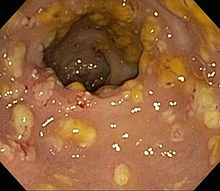[1]
de Curraize C, Rousseau C, Corvec S, El-Helali N, Fihman V, Barbut F, Collignon A, Le Monnier A. Variable spectrum of disease and risk factors of peripartum Clostridium difficile infection: report of 14 cases from French hospitals and literature review. European journal of clinical microbiology & infectious diseases : official publication of the European Society of Clinical Microbiology. 2018 Dec:37(12):2293-2299. doi: 10.1007/s10096-018-3372-x. Epub 2018 Sep 3
[PubMed PMID: 30178230]
Level 3 (low-level) evidence
[2]
Khanafer N, Vanhems P, Barbut F, Eckert C, Perraud M, Vandenesch F, Luxemburger C, Demont C, CDI01 Study Group. Outcomes of Clostridium difficile-suspected diarrhea in a French university hospital. European journal of clinical microbiology & infectious diseases : official publication of the European Society of Clinical Microbiology. 2018 Nov:37(11):2123-2130. doi: 10.1007/s10096-018-3348-x. Epub 2018 Aug 17
[PubMed PMID: 30120646]
[3]
Dicks LMT, Mikkelsen LS, Brandsborg E, Marcotte H. Clostridium difficile, the Difficult "Kloster" Fuelled by Antibiotics. Current microbiology. 2019 Jun:76(6):774-782. doi: 10.1007/s00284-018-1543-8. Epub 2018 Aug 6
[PubMed PMID: 30084095]
[4]
Prechter F, Stallmach A. [Clostridium difficile in the intensive care unit]. Medizinische Klinik, Intensivmedizin und Notfallmedizin. 2020 Mar:115(2):81-87. doi: 10.1007/s00063-018-0459-1. Epub 2018 Jul 11
[PubMed PMID: 29995234]
[5]
Sachu A, Dinesh K, Siyad I, Kumar A, Vasudevan A, Karim S. A prospective cross sectional study of detection of Clostridium difficile toxin in patients with antibiotic associated diarrhoea. Iranian journal of microbiology. 2018 Feb:10(1):1-6
[PubMed PMID: 29922412]
[6]
Schäffler H, Breitrück A. Clostridium difficile - From Colonization to Infection. Frontiers in microbiology. 2018:9():646. doi: 10.3389/fmicb.2018.00646. Epub 2018 Apr 10
[PubMed PMID: 29692762]
[7]
Papatheodorou P, Barth H, Minton N, Aktories K. Cellular Uptake and Mode-of-Action of Clostridium difficile Toxins. Advances in experimental medicine and biology. 2018:1050():77-96. doi: 10.1007/978-3-319-72799-8_6. Epub
[PubMed PMID: 29383665]
Level 3 (low-level) evidence
[8]
Wessling J. [Radiological imaging of acute infectious and non-infectious enterocolitis]. Der Radiologe. 2018 Apr:58(4):302-311. doi: 10.1007/s00117-018-0379-3. Epub
[PubMed PMID: 29569035]
[9]
Jessurun J. The Differential Diagnosis of Acute Colitis: Clues to a Specific Diagnosis. Surgical pathology clinics. 2017 Dec:10(4):863-885. doi: 10.1016/j.path.2017.07.008. Epub
[PubMed PMID: 29103537]
[10]
Al Momani LA, Abughanimeh O, Boonpheng B, Gabriel JG, Young M. Fidaxomicin vs Vancomycin for the Treatment of a First Episode of Clostridium Difficile Infection: A Meta-analysis and Systematic Review. Cureus. 2018 Jun 11:10(6):e2778. doi: 10.7759/cureus.2778. Epub 2018 Jun 11
[PubMed PMID: 30112254]
Level 1 (high-level) evidence
[11]
von Braun A, Lübbert C. [Treatment of acute and recurrent Clostridium difficile infections : What is new?]. Der Internist. 2018 May:59(5):505-513. doi: 10.1007/s00108-018-0401-x. Epub
[PubMed PMID: 29536125]
[12]
Shen NT, Maw A, Tmanova LL, Pino A, Ancy K, Crawford CV, Simon MS, Evans AT. Timely Use of Probiotics in Hospitalized Adults Prevents Clostridium difficile Infection: A Systematic Review With Meta-Regression Analysis. Gastroenterology. 2017 Jun:152(8):1889-1900.e9. doi: 10.1053/j.gastro.2017.02.003. Epub 2017 Feb 10
[PubMed PMID: 28192108]
Level 1 (high-level) evidence
[13]
van der Wilden GM, Velmahos GC, Chang Y, Bajwa E, O'Donnell WJ, Finn K, Harris NS, Yeh DD, King DR, de Moya MA, Fagenholz PJ. Effects of a New Hospital-Wide Surgical Consultation Protocol in Patients with Clostridium difficile Colitis. Surgical infections. 2017 Jul:18(5):563-569. doi: 10.1089/sur.2016.041. Epub 2017 May 30
[PubMed PMID: 28557651]
[14]
Cruz-Betancourt A, Cooper CD, Sposato K, Milton H, Louzon P, Pepe J, Girgis R, Patel SV, Ibrahim D, Van Horn S, Hsu V. Effects of a predictive preventive model for prevention of Clostridium difficile infection in patients in intensive care units. American journal of infection control. 2016 Apr 1:44(4):421-4. doi: 10.1016/j.ajic.2015.11.010. Epub 2016 Jan 5
[PubMed PMID: 26775936]
[15]
Vassallo A, Tran MC, Goldstein EJ. Clostridium difficile: improving the prevention paradigm in healthcare settings. Expert review of anti-infective therapy. 2014 Sep:12(9):1087-102. doi: 10.1586/14787210.2014.942284. Epub
[PubMed PMID: 25109301]
[16]
Venkat R, Pandit V, Telemi E, Trofymenko O, Pandian TK, Nfonsam VN. Frailty Predicts Morbidity and Mortality after Colectomy for Clostridium difficile Colitis. The American surgeon. 2018 May 1:84(5):628-632
[PubMed PMID: 29966560]

